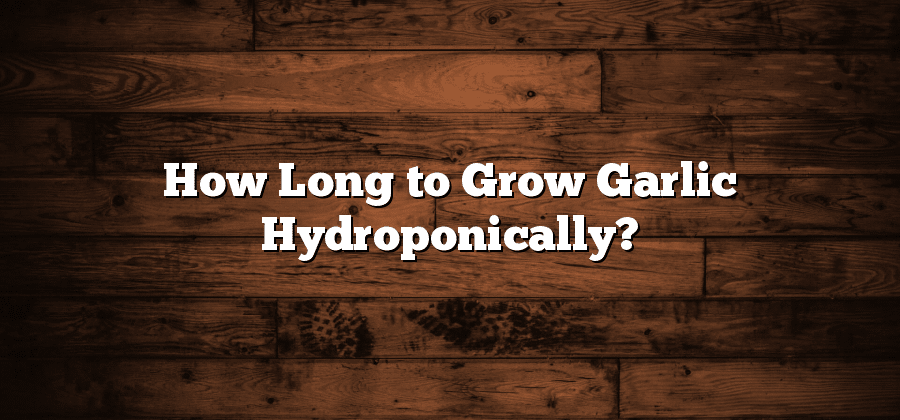Benefits of growing garlic hydroponically
Garlic, known for its distinct flavor and numerous health benefits, has gained popularity in the realm of hydroponics cultivation. Growing garlic hydroponically presents several advantages over traditional soil-based methods.
Firstly, growing garlic hydroponically allows for better control over the plant’s environment. By eliminating the uncertainties associated with soil conditions, hydroponic systems provide optimal conditions for garlic growth, resulting in healthier and more vigorous plants. The ability to regulate factors such as light, temperature, and nutrient availability enables growers to create an ideal environment that promotes the maximum yield potential of garlic.
Furthermore, hydroponic garlic cultivation offers space-saving benefits. Unlike traditional soil-based methods, hydroponics requires less physical space, making it a viable option for urban farmers or those with limited garden area. This compactness also allows for increased plant density, which directly translates to higher garlic yields per square foot. For commercial growers, this means maximizing profits by efficiently utilizing limited space and resources.
Selecting the right garlic variety for hydroponic cultivation
When it comes to selecting the right garlic variety for hydroponic cultivation, there are a few factors to consider. First and foremost, you want to choose a variety that is suitable for growing in a controlled environment. Some garlic varieties are better suited for traditional soil cultivation, while others have been specifically bred for hydroponics.
Secondly, it’s important to look for garlic varieties that have a shorter growing cycle. Since hydroponic systems provide ideal growing conditions, garlic can grow faster compared to traditional soil cultivation. Opting for a variety with a shorter growing cycle will allow you to harvest your garlic crop sooner.
Additionally, you may want to consider the flavor and bulb size of the garlic variety. Different garlic varieties exhibit varying degrees of flavor profiles, ranging from mild and nutty to bold and spicy. Similarly, bulb size can vary, so selecting a variety that meets your preferences or market demands is crucial. By carefully considering these factors, you can ensure a successful and productive hydroponic garlic cultivation.
Understanding the growth stages of garlic
After planting garlic bulbs in a hydroponic system, the growth stages of garlic can be observed and monitored. The first stage is the emergence stage, where the shoots start to push through the growing medium. It is crucial to ensure that the emerging shoots receive sufficient light and air circulation to promote healthy growth.
Once the shoots emerge, the garlic enters the vegetative stage. During this stage, the plant focuses on developing a strong root system and growing lush green leaves. It is essential to provide optimal growing conditions, such as maintaining the ideal temperature and humidity levels, to support the plant’s growth during this stage. Regular monitoring of the plant’s nutrient levels and adjusting them accordingly is also crucial to ensure a healthy and vigorous vegetative growth stage.
Providing optimal growing conditions for hydroponic garlic
Maintaining optimal growing conditions is crucial for successful hydroponic cultivation of garlic. The first step in providing these conditions is to ensure proper lighting. Garlic plants require at least 12 hours of light per day, so it is essential to invest in high-quality grow lights that emit the right spectrum of light for photosynthesis.
In addition to lighting, maintaining the right temperature and humidity levels is essential. Garlic grows best in temperatures between 60 and 80 degrees Fahrenheit, with a humidity level of around 60 to 70 percent. To achieve these conditions, it may be necessary to use heaters or fans to regulate temperature and humidity levels in the hydroponic system. Proper ventilation is also important to prevent the buildup of excess moisture, which can lead to fungal diseases. By providing the right growing conditions, hydroponic garlic plants can thrive and produce healthy, flavorful bulbs.
Nutrient requirements for garlic cultivation in hydroponics
Garlic cultivation in hydroponics requires careful attention to nutrient requirements in order to achieve optimal growth and yield. Unlike traditional soil-based cultivation, hydroponic systems rely on nutrient solutions to provide essential elements for plant development. The nutrient requirements for garlic in hydroponics include a balanced supply of macronutrients, such as nitrogen, phosphorus, and potassium, as well as micronutrients like iron, manganese, and zinc.
Nitrogen is crucial for plant growth as it promotes leaf and stem development, while phosphorus aids in root formation and flower development. Potassium, on the other hand, helps with overall plant health and disease resistance. It is important to maintain the right balance of these macronutrients, as an excess or deficiency can lead to nutrient imbalances and hinder garlic growth. In addition to macro elements, garlic also requires adequate amounts of micronutrients, which play crucial roles in enzyme activation and metabolic processes. These micronutrients are often provided through nutrient solutions or supplements, ensuring the plants have access to all the essential elements they need for healthy growth.






